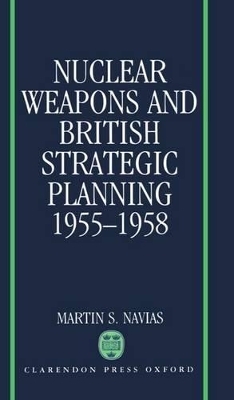
Nuclear Weapons and British Strategic Planning, 1955-1958
Seiten
1991
Clarendon Press (Verlag)
978-0-19-827754-5 (ISBN)
Clarendon Press (Verlag)
978-0-19-827754-5 (ISBN)
During the 1950s nuclear weapons began to play an increasingly important role in Britain's defence policy. This study analyzes the significance of the 1957 Defence White Paper in the context of British strategic planning.
During the 1950s nuclear weapons began to play an increasingly important role in Britain's defence policy. The development of thermonuclear bombs and assessments of the great destruction that would result from an exchange of nuclear warheads helped alter Britain's planning for war, and influenced the structure and deployment of her armed forces.
In this study Martin Navias seeks to analyse the significance of the 1957 White Paper on Defence in the context of British strategic planning during the mid-1950s. He assesses claims that the White Paper represented a culmination of trends already prevalent in British defence planning, discusses whether the basis for a truly independent deterrent was established during 1955-6, and identifies continuities and discontinuities in strategic policies.
A major theme throughout is the relationship between nuclear deterrence and the shape and size of conventional forces. Before Duncan Sandys became Minister of Defence, that ministry seemed unable to impose itself on the service departments. Sandys, however, was able to override many traditional service preferences. The result was the adoption of a British New Look: conventional forces were reduced, greater relative importance was placed on the nuclear deterrent, but once more the requirements of a truly independent deterrent did not receive priority.
During the 1950s nuclear weapons began to play an increasingly important role in Britain's defence policy. The development of thermonuclear bombs and assessments of the great destruction that would result from an exchange of nuclear warheads helped alter Britain's planning for war, and influenced the structure and deployment of her armed forces.
In this study Martin Navias seeks to analyse the significance of the 1957 White Paper on Defence in the context of British strategic planning during the mid-1950s. He assesses claims that the White Paper represented a culmination of trends already prevalent in British defence planning, discusses whether the basis for a truly independent deterrent was established during 1955-6, and identifies continuities and discontinuities in strategic policies.
A major theme throughout is the relationship between nuclear deterrence and the shape and size of conventional forces. Before Duncan Sandys became Minister of Defence, that ministry seemed unable to impose itself on the service departments. Sandys, however, was able to override many traditional service preferences. The result was the adoption of a British New Look: conventional forces were reduced, greater relative importance was placed on the nuclear deterrent, but once more the requirements of a truly independent deterrent did not receive priority.
Introduction; Nuclear weapons and British Alliance commitments 1955-1956; The services and war planning in the thermonuclear era 1955-1956; The nuclear deterrent 1955-1956: Moving towards independence?; The Sandys White Paper of 1957; Independent deterrence and Anglo-American Co-operation: 1957-1958; Conclusion
| Erscheint lt. Verlag | 16.5.1991 |
|---|---|
| Reihe/Serie | Nuclear History Program ; 1 |
| Verlagsort | Oxford |
| Sprache | englisch |
| Maße | 145 x 223 mm |
| Gewicht | 499 g |
| Themenwelt | Natur / Technik ► Fahrzeuge / Flugzeuge / Schiffe ► Militärfahrzeuge / -flugzeuge / -schiffe |
| Geschichte ► Allgemeine Geschichte ► Zeitgeschichte | |
| Geisteswissenschaften ► Geschichte ► Regional- / Ländergeschichte | |
| Sozialwissenschaften ► Politik / Verwaltung | |
| ISBN-10 | 0-19-827754-7 / 0198277547 |
| ISBN-13 | 978-0-19-827754-5 / 9780198277545 |
| Zustand | Neuware |
| Haben Sie eine Frage zum Produkt? |
Mehr entdecken
aus dem Bereich
aus dem Bereich
von der Machtergreifung bis zur Gründung der Vereinten Nationen
Buch | Softcover (2023)
Motorbuch Verlag
CHF 38,90


